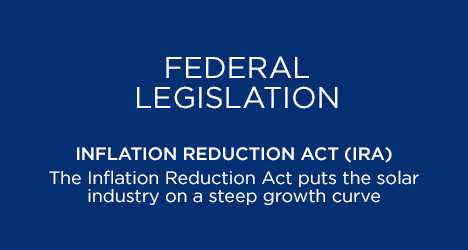Working with EPCs — End-to-End Renewable Energy Engineering Learn More
The Inflation Reduction Act puts the solar industry on a steep growth curve

Federal legislation for the Inflation Reduction Act (IRA) creates a historic opportunity for growth in the renewable energy industry. Expansions and modifications to key clean-energy tax credits, as well as investments in transmission infrastructure to increase access to and the supply of renewable energy combine to make the cost of commercial and utility-scale installations more reachable than they’ve ever been.
One of the critical tax credit opportunities in the bill is the restoration and ten-year extension of the solar Industry Tax Credit (ITC) at 30%, if prevailing wage and apprenticeship requirements are met. This is comprised of a 6% base tax rate and a 24% bonus credit for those requirements, and now includes solar storage. If wage and apprenticeship requirements are met and domestic content requirements are, as well, 10% is added to the tax credit. Projects placed in an “energy community, such as those with past brownfield sites or a high population of coal or mining jobs” are eligible for a further 10%, making the potential ITC 50%. The Production Tax Credit (PTC) is reinstated and extended, and features the same incentives for increased tax credit.
According to the SEIA, the following benefits can be expected in the solar industry:
- Over the next 10 years, the IRA will lead to 69% more solar deployment than would otherwise be expected under a no-IRA scenario.
- By 2032, the U.S. will have installed 682 GW of total solar capacity, more than 5 times the amount installed today.
- By 2032, solar energy will produce more electricity each year than all U.S. coal-fired power plants in 2021.
- The solar industry’s annual CO2 emissions offsets will increase from 139 million metric tons (MMT) today to more than 492 MMT by 2032.
- 10 years from now, there will be enough solar power installed to power nearly every home east of the Mississippi.
“The Inflation Reduction Act represents the biggest opportunity for new solar projects we’ve ever seen,” says Blymyer Engineers President Mike Rantz. “The new tax incentives and federal investments represent a win for jobs and the industry, as well as for the environment.”
“We look forward to lending our expertise to new projects and leveraging our two decades in the industry to help drive the growth of commercial and utility-scale solar,” adds Director of Engineering Greg Mazur. “With our additional experience in storage and substations, we are poised to help projects get off the ground quickly and successfully.”